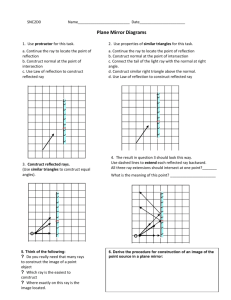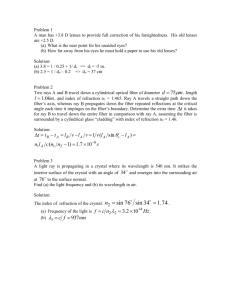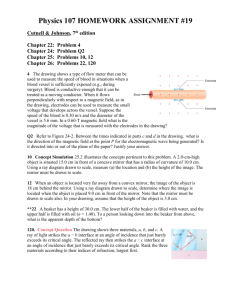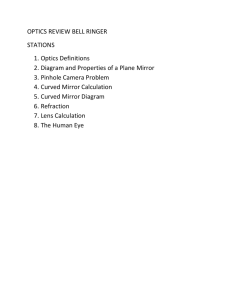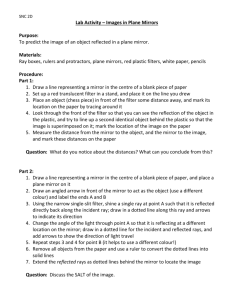P21 Homework Set #8
advertisement
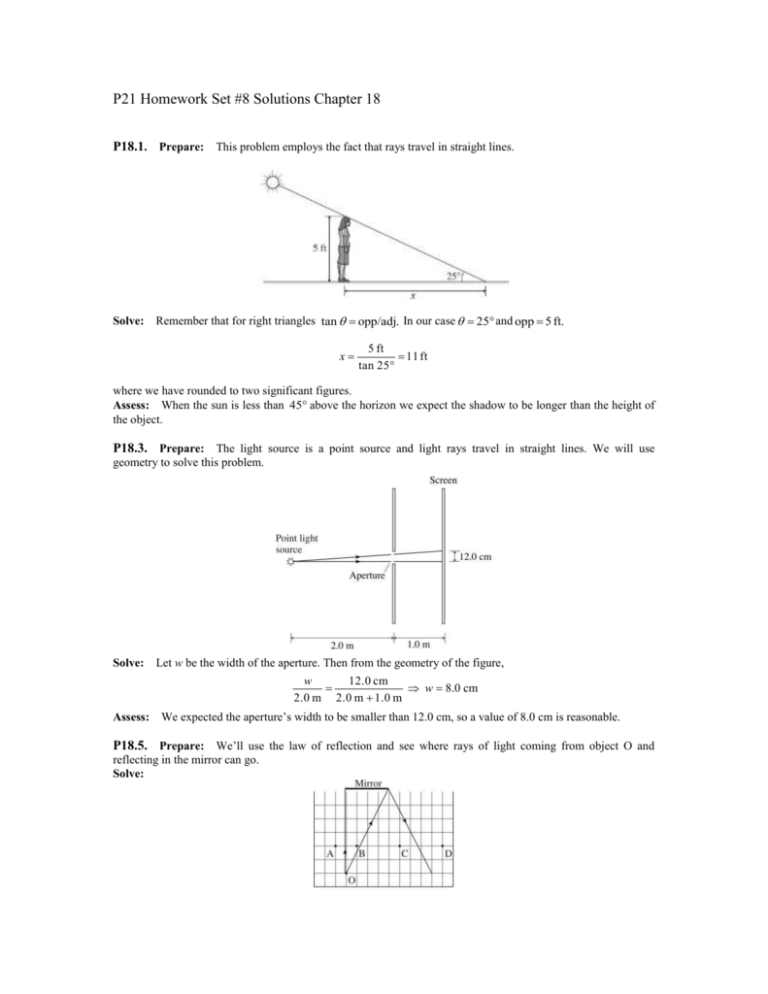
P21 Homework Set #8 Solutions Chapter 18 P18.1. Prepare: This problem employs the fact that rays travel in straight lines. Solve: Remember that for right triangles tan opp/adj. In our case 25 and opp 5 ft. x 5 ft 11 ft tan 25 where we have rounded to two significant figures. Assess: When the sun is less than 45 above the horizon we expect the shadow to be longer than the height of the object. P18.3. Prepare: The light source is a point source and light rays travel in straight lines. We will use geometry to solve this problem. Solve: Let w be the width of the aperture. Then from the geometry of the figure, w 12.0 cm w 8.0 cm 2.0 m 2.0 m 1.0 m Assess: We expected the aperture’s width to be smaller than 12.0 cm, so a value of 8.0 cm is reasonable. P18.5. Prepare: We’ll use the law of reflection and see where rays of light coming from object O and reflecting in the mirror can go. Solve: The figure shows rays coming from O and hitting each end of the mirror. It is clear that object O can be seen in the mirror from any location between the outer rays, which includes locations B and C. However, at location A object O can’t be seen in the mirror because there is no way for a ray to obey the law of reflection from O and get to A. If the mirror extended further to the left, then A could see O. A similar argument can be made that object O can’t be seen in the mirror from position D. In summary, the object’s image is visible from B and C. Assess: Your intuition in looking at the original diagram confirms what the ray tracing tells us. P18.7. Prepare: Use the ray model of light and the law of reflection. We only need one ray of light that leaves your toes and reflects in your eye. Solve: From the geometry of the diagram, the distance from your eye to the toe’s image is 2d (400 cm) 2 (165 cm) 2 433 cm Assess: The light appears to come from your toe’s image. P18.9. Prepare: Treat the red ball as a point source and use the ray model of light. Solve: (a) Using the law of reflection, we can obtain three images of the red ball as shown below. (b) The images of the ball are located at B, C, and D. Relative to the intersection point of the two mirrors, the coordinates of B, C, and D are as follows: B (1 m, 2 m), C (1 m, 2 m) and D (1 m, 2 m). (c) P18.11. Prepare: Represent the laser beam with a single ray and use the ray model of light. We will use Snell’s law to find the unknown index of refraction. Solve: Using Snell’s law at the air–water boundary, nair sin air nliquid sin liquid nliquid nair sin 37 sin air 1.0 1.4 sin liquid sin 26 Assess: As expected, nliquid is larger than nair. P18.13. Prepare: Use the ray model of light and the law of refraction. Assume the sun is a point source of light. Use the ray model of light. When the bottom of the pool becomes completely shaded, a ray of light that is incident at the top edge of the swimming pool does not reach the bottom of the pool after refraction. A visual overview of the problem is shown below in which the first four steps of Tactics Box 18.1 have been identified. Solve: have The depth of the swimming pool is d 4.0 m/tan water. We will find the angle by using Snell’s law. We 4.0 m sin 70 nwater sin water nair sin 70 water sin 1 44.95 d tan 44.95 4.0 m 1.33 Assess: A depth of 4.0 m for the pool’s depth is reasonable. Also, note that the angles of incidence and refraction are measured from the normal. P18.15. Prepare: Use the ray model of light. For an angle of incidence greater than the critical angle, the ray of light undergoes total internal reflection. The critical angle of incidence is given by Equation 18.3. The indexes of refraction are given in Table 18.1. Solve: noil 1.46 sin 1 76.7 nglass 1.50 The critical angle exists because noil nglass. c sin 1 Assess: P18.17. Prepare: Represent the can as a point source and use the ray model of light. Paraxial rays from the can refract into the water and enter into the fish’s eye. The ray-tracing diagram is shown. Solve: The object distance from the edge of the aquarium is s. From the water side, the can appears to be at an image distance s 30 cm. Using Equation 18.7, s 30 cm n2 n 1.33 s water s s s 1.33 23 cm n1 nair 1.0 Assess: The ray-tracing diagram above and the indices of refraction for water and air indicate the actual distance to be less than 30 cm. A value of 23 cm is reasonable. P18.39. Prepare: Assume the department store mirror is flat so that Suzanne’s image is as far behind the mirror as she is in front. For simplicity, also assume the mirror is vertical. Solve: In 2.0 s Suzanne moves x vt (15 m/s)(20 s) 30 m toward the mirror. Her image also moves 3.0 m toward the mirror in the same time. Suzanne is now 0.50 m in front of the mirror and her image is 0.5 m behind the mirror, so Suzanne is 1.0 m from her image. Assess: Suzanne and her image approach each other at a speed of 2v, or 3.0 m/s. They started 7.0 m apart so after 2.0 s they will be 7.0 m (30 m/s)(20 s) 10 m apart.

